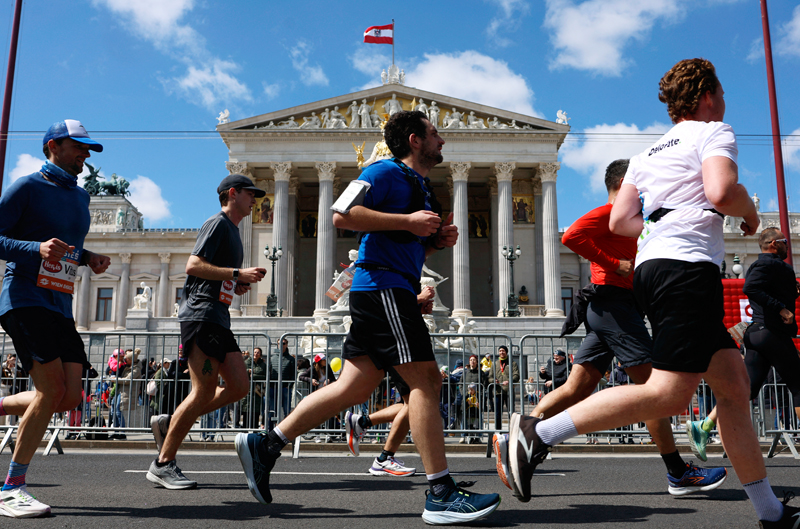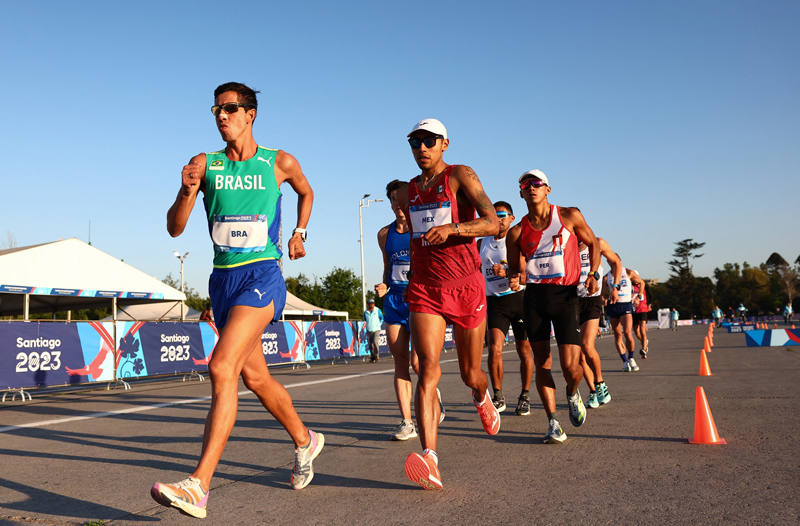If the pounds come off deceptively easily, beware! It's not fat that you're losing
If your body burned only fat for energy when you exercised, and you wanted to lose a pound of weight by working out, you would have to run or walk about 35 miles to lose that pound.*
In contrast, if your body burned only carbohydrate (glycogen) while you trained, you could lose that same pound after just 18 miles of running or walking.*
Crazy? Yes, but it’s also unavoidable. The simple truth is that it’s much easier to lose weight when your body burns carbos rather than fat, because fat is such an energy-dense substance, packing so many calories into each gram, ounce, or pound of the stuff. A gram of fat packs nine calories, while a gram of glycogen holds a mere four calories. As a result, you can burn a lot of fat calories without having much impact on your weight.
That may seem strange, but mother nature set up our bodies that way for good reason. Throughout evolutionary time, humans have been nomadic sorts, moving here and there in search of ’greener pastures’. Unfortunately, humans have also been prone to ’boom-and-bust’ cycles - having lots of food at one point in time and then nearly starving to death a few months later. Consequently, we needed a way to store energy without bogging our bodies down with a heavy armour plating of weight, and fat filled the bill nicely. Unless we swell to the dimensions of Mr Blobby, that foamy, flabby material which drapes our internal organs and lies like a blanket directly beneath our skin is relatively light and portable - yet very calorie-rich.
This Darwinesque view of fat makes an interesting story, but there’s also a fascinating consequence of fat’s lightness and richness which is often overlooked: if you manage to lose weight quickly, you’re probably not losing fat weight. To understand this, remember that even without eating a thing, it still takes a fairly light person about two days to lose a pound of weight when fat is the fuel. Yet, quick weight loss is what everyone seems to want - and of course it is what the very prosperous weight-loss industry promises to its clients unrelentingly.
Why ’quick’ equals ’bad’
That’s of course one reason why our bodies’ glycogen stores are strictly limited, while fat storage can be nearly endless. An average individual’s body can sock away no more than 400 grams of glycogen, enough to run or walk about 16 miles or so. That’s not even one pound of the stuff. Ma nature was so worried about excess weight that she put a strict upper limit on glycogen stockpiling.
Since fat is so lightweight, she put no limits at all on fat stockage, never envisioning that humans would ever have year-round access to a vast larder of food. As a result, the average American or Brit has no problem filling up with 50 to 60 pounds of tallow (figuring a 30-per cent fat composition in a 180-pound body).
These harsh realities have recently been brought to our attention once again by those thorough researchers at the Howard Foundation and Cambridge University in the UK. As they point out, the human body’s quickness to dispense glycogen weight and reluctance to lose fat mass have dispiriting consequences for people trying to lose weight - and extremely important implications for individuals interested in endurance exercise (’Glycogen Storage: Illusions of Easy Weight Loss, Excessive Weight Regain, and Distortions in Estimates of Body Composition, American Journal of Clinical Nutrition, vol. 56, pp. 292S-293S, 1992).
The key nettlesome point for people desirous of weight loss is that if poundage is lost primarily by burning carbohydrate (glycogen), that weight will literally leap back onto the body once carbohydrate-containing meals are consumed. For one thing, while the body doesn’t store much carbohydrate, it is sorely troubled if carbohydrate is temporarily lost - and will fight to get it back. However, there’s yet another reason for this rapid weight re-gain: Carbohydrate (glycogen) has an immense affinity for water.
Yes, whenever a gram of glycogen is socked away in a muscle fibre or liver cell, three to four grams of water are tucked in with it. This means, in effect, that if you’ve lost a pound of carbos from your body, a simple meal of a glass of water and just 100 grams of carbohydrate (just slightly more than one-fifth of a pound and a paltry 400 calories) could put that pound of weight right back. After all, 100 grams of carbohydrate plus 350 grams (12 ounces) of H2O stored with the carbos adds up to 450 grams, or one pound. If this happens repeatedly to the poor soul who is trying to lose weight (and who may have initially rejoiced at the loss of a pound or two), he or she may deduce that PERMANENT weight loss is impossible and give up the struggle.
Starving at Cambridge
After four days of Cambridge starvation, the subjects lost an average of nine pounds! They were happy, until the researchers filled them in on what was really going on. Basically, about one of those lost pounds was pure glycogen. Figuring that four pounds of water were lost with this solitary carbohydrate pound, five out of the nine pounds dropped (56 per cent) were good things that the dieters’ bodies really needed. It’s hard to know from the study how much protein (muscle) was converted to carbohydrate and then burned up for fuel, too, but when one does the appropriate calculations, it’s very difficult to believe that the subjects lost more than two pounds of fat. So, at least 78 per cent of the weight lost was good stuff (glycogen, protein, and water).
Now, let’s say that these people were satisfied with their nine-pound weight-loss and decided to go back to normal - but not excessive - eating. One of the first things their bodies would do would be to re-stock that missing pound of glycogen (remember that although the body gives up carbohydrate rather freely, it will try desperately to get that glycogen back, if given a chance). That would mean that five pounds (one pound glycogen and four pounds water) would return to the dieters’ carcasses in a very short period of time.
And that’s the best-case scenario! Swedish studies have shown that when one follows carbohydrate depletion with adequate carbohydrate replenishment, glycogen storage can sometimes soar to more than twice normal (’Diet, Muscle Glycogen, and Physical Performance,’ Acta Physiologica Scandinavica, vol. 71, pp. 140-150, 1967). In the Cambridge case, that could mean up to two pounds of glycogen and eight pounds of water, or a total gain of 10 pounds within a short period of time. That would be a net gain of one pound for our Cambridge victims, despite their four days of starvation misery. Easy go, easy come!
The bottom line? Despite the rosy claims made by the marketers of quick-weight-loss products, weight lost easily is weight regained even more readily. To lose weight properly, it’s important to hang on to your glycogen stores and water and trim away fat slowly and steadily. That will give you dependable, accurate weight loss (you’ll be measuring real drops in fat rather than water lost down the drain). It will also keep your muscles healthy (they need glycogen to function normally and to exercise at decent intensities). Remember that your muscles are the ’engines’ which drive appropriate weight loss by burning calories at substantial rates. Your engines will work at only about half-throttle (and thus will burn calories at sub-par rates) if they don’t have adequate glycogen fuel.
If you’re an endurance athlete, you need to bear in mind that a simple five-mile run can wipe out one-quarter of your glycogen stores, while a 10-mile effort can take away half. You will also lose weight in the process, since glycogen is a heavy material, but you need to always remember that it can NOT be PERMANENT weight loss. You absolutely must have that glycogen back if you want to train at a strenuous level. The only way to make sure you’ve got enough glycogen is to ingest about four grams (16 calories) of carbohydrate per pound of body weight per day when you’re training regularly.
’But I’ll gain too much weight if I do that,’ you may protest loudly. True, you will gain, but it’s good gain - the glycogen and water you need to stay healthy and work out at a decent level. Once you’re in glycogen equilibrium, you’ll start to lose real weight - by chipping away at your fat stores. The only dependable way to lose fat weight is to keep your glycogen well-stocked and get yourself in slightly negative energy balance several days each week (negative balance means burning more calories than you eat). These missing calories have to come from somewhere, and if you’re keeping your glycogen stores in line, they can only come from fat.
Remember that although fat loss is a slow process, you can still lose considerable amounts of blubber if you give yourself enough time. For example, if you don’t change your diet, jogging just three extra miles per week can help you lose four pounds of fat in a year - and 20 pounds of fat in five years. Be patient, and don’t get discouraged. When weight is lost quickly, it is usually fool’s weight. When weight is lost slowly, it is usually the excess adipose tissue that you don’t want or need.
Jim Bledsoe
*To simplify things, we are ignoring weight lost via sweating, urination, and respiration in these examples. In actual fact, since three to four grams of water are stored with each gram of glycogen, the excess urination associated with the ’glycogen burns’ would produce even larger weight loss in the glycogen case, because as the glycogen was removed from storage and broken down, the water stored with it would cascade into the blood plasma and be carried to the kidneys.
You need to be logged in to continue reading.
Please register for limited access or take a 30-day risk-free trial of Sports Performance Bulletin to experience the full benefits of a subscription. TAKE A RISK-FREE TRIAL
TAKE A RISK-FREE TRIAL
Newsletter Sign Up
Testimonials
Dr. Alexandra Fandetti-Robin, Back & Body Chiropractic
Elspeth Cowell MSCh DpodM SRCh HCPC reg
William Hunter, Nuffield Health
Further reading
Newsletter Sign Up
Coaches Testimonials
Dr. Alexandra Fandetti-Robin, Back & Body Chiropractic
Elspeth Cowell MSCh DpodM SRCh HCPC reg
William Hunter, Nuffield Health
Keep up with latest sports science research and apply it to maximize performance
Today you have the chance to join a group of athletes, and sports coaches/trainers who all have something special in common...
They use the latest research to improve performance for themselves and their clients - both athletes and sports teams - with help from global specialists in the fields of sports science, sports medicine and sports psychology.
They do this by reading Sports Performance Bulletin, an easy-to-digest but serious-minded journal dedicated to high performance sports. SPB offers a wealth of information and insight into the latest research, in an easily-accessible and understood format, along with a wealth of practical recommendations.
*includes 3 coaching manuals
Get Inspired
All the latest techniques and approaches
Sports Performance Bulletin helps dedicated endurance athletes improve their performance. Sense-checking the latest sports science research, and sourcing evidence and case studies to support findings, Sports Performance Bulletin turns proven insights into easily digestible practical advice. Supporting athletes, coaches and professionals who wish to ensure their guidance and programmes are kept right up to date and based on credible science.









